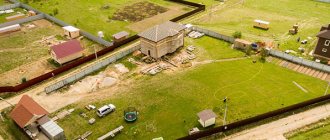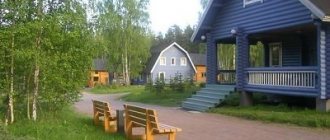On April 26, the Supreme Court of the Russian Federation published a review of judicial practice in cases of establishing an easement on a land plot. We will share the main findings.
You will find out which court to apply to establish, change the conditions or terminate the easement. We will explain what to do if the Unified State Register of Real Estate does not contain information about part of the land plot encumbered by an easement.
Formation of a land plot under a blocked building
What is an easement and how to get one
We have already told you that an easement is the right to limited use of someone else’s real estate (Article 1 N 122-FZ). This right is transferred to another person by right of encumbrance.
The right of encumbrance is otherwise called the right of limitation. Its definition is given in paragraph 1 of Article 1 of the Law on State Registration of Rights. The law or authorized bodies establish restrictions for the land owner in the exercise of ownership or other proprietary rights to a land plot.
Residents of neighboring houses may need an easement in order to lay communications through someone else’s land and use them. An easement may exist independently of the use of the land plot.
If you have received an easement, this does not mean that the plot has passed into your possession and its owners have lost the right to use it (Clause 2 of Article 274 of the Civil Code of the Russian Federation). The owners continue to use it, but for a specific purpose, which is established by contract or agreement.
To obtain an easement, you need to obtain the consent of the owners of the apartment complex. A simple majority of votes at the OCC will be sufficient. After this, an agreement or contract is concluded. This document is included in the technical documentation of the MKD.
Read more about what an easement is and how to get one
Reasons why a private easement may be established
Legal access to someone else's property may be required for a variety of reasons. According to Article 274 of the Civil Code of the Russian Federation, an easement can be established when the following circumstances arise:
- Obtaining the legal right to pass through a neighbor’s property;
- Laying communication lines, power transmission or pipelines;
- Supplying the land with water;
- Ensuring that other landowner needs are met.
In accordance with the Federal Law “On Livestock Breeding,” there may also be other reasons for establishing an easement:
- The need to provide water for animals;
- Impossibility of raising livestock;
- The need to ensure drainage and collection of water.
The person who has acquired the title to the easement becomes the “authorized person,” and the owner of the encumbered land becomes the “obligated party.”
Which court considers easement issues?
To accurately determine which court to contact to resolve issues of easement, clarify the subject composition of the parties to the dispute and the nature of the legal relationship. There are two options - a court of general jurisdiction or an arbitration court.
According to Parts 1 and 2 of Art. 27 of the Arbitration Procedure Code of the Russian Federation, arbitration courts consider:
- economic disputes;
- cases involving legal entities and individuals carrying out entrepreneurial activities
- activities without forming a legal entity and having the status of individual entrepreneurs;
- cases involving the Russian Federation, constituent entities of the Russian Federation, municipalities, government bodies, etc.
Courts of general jurisdiction deal with cases provided for in Parts 1 and 2 of Art. 22 Code of Civil Procedure of the Russian Federation. But economic disputes and cases dealt with by arbitration courts are not resolved.
An easement is requested in relation to real estate that can be used for business activities:
- if the parties to the dispute have the status of entrepreneurs,
- if the dispute is between individual entrepreneurs regarding land not used for business activities.
But this fact does not mean that the dispute is of an economic nature and should be considered by an arbitration court.
The Supreme Court cites the district court's ruling as an example. He terminated the proceedings on the claim for the establishment of an easement. The plaintiff had the status of an individual entrepreneur and asked to establish an easement in relation to the land. He needed the easement to provide access to his land plot and non-residential premises.
The district court found that the plaintiff was the owner of a commercial property. His interest is to ensure the passage of transport for the transport of goods. The dispute was of an economic nature and therefore had to be considered by an arbitration court.
But courts of general jurisdiction do not always have the authority to resolve such disputes. For example, a dispute over the cancellation of an easement can be considered by a court of general jurisdiction and an arbitration court. It all depends on which court established the easement.
Registration of a land plot into the common property of the MKD
Grounds for termination of a public easement
As judicial practice shows, most often the basis for terminating a public easement is the expiration of the regulatory legal act by which the restrictive right was imposed, for example, upon completion of the relevant work. In this case, all work may be completed earlier than indicated in the act.
The owner of a land plot has the right to contact the local administration, representatives of local authorities, in order to terminate the public easement. No one can deny him this.
If, during the validity of the public easement act, the owner’s land plot was subject to cardinal changes of a negative nature (damaged or rendered unsuitable for further use), then the owner has the right to go to court to obtain material compensation or sell this plot in favor of the municipality according to its cadastral value. An independent assessment of the damage by an expert will come in handy here.
Permanent (perpetual) basis: what is it?
An easement on a permanent basis or perpetual use is the imposition of an encumbrance on a piece of land without specifying a period of validity. The territory can be used until the following moments:
- until this need no longer exists;
- if one of the parties violates the terms of use;
- one of the parties died;
- terms of use have changed.
The legislation does not strictly regulate the validity period for a perpetual easement. Its legal force is valid as long as there is a need for use in the site or the objects located on it.
Reference. The urgency of the problem associated with the limited use of land by a third party who is not the owner determines the validity period of the easement encumbrance.
An indefinite encumbrance is in effect continuously until real conditions change, which allow that the easement can also be urgent.
It is especially convenient to do this design when laying communications, road routes or electrical networks.
Reasons for overlap
There are the following reasons for imposing a permanent (indefinite) type of easement:
- the deadlines for completing work through the neighboring area are blurred;
- access to a linear or engineering facility is required on an ongoing basis or as needed;
- priority location over another site;
- in the absence of other approaches to one’s own site, only through someone else’s property.
More information about the grounds for establishing various types of easements can be found here.
Important. This type is used when imposing an encumbrance, provided that the territorial owners have a single land border (the owners are neighbors).
Design methods
According to the Land Code, the following methods for registering an easement are established:
- According to the will of the owner , it is formalized through an agreement or legate.
- Due to usukapia - due to the recency of acquisition of ownership (10 or 20 years ago).
- By a court decision , an interested citizen can force through the court to impose an encumbrance on the land territory of a neighboring owner in order to fulfill his tasks (on what grounds you can apply to the court for a compulsory easement, read here).
About 300 years ago, the first Olkha settlements appeared on the banks of the Bolshaya and Malaya Olkha rivers. The village was populated mainly by newcomers, also by Cossacks who came with Ataman Pokhabov. In 1832, the village had 39 households, where 277 peasants lived, and in 1911 - 188 households and 1062 peasants. Today 1,936 people live in Olkha.
Back in the 18th century, lime was mined in the village of Olkha; it was used in the construction of churches, cathedrals and houses in Irkutsk. The Olkha dolomite deposit is also known.
From the second half of the 19th century, the Cossack hundred of the Irkutsk Cavalry Regiment was stationed in the village, which played a significant role in the life of the village. According to the recollections of old-timers, the founder of the village was Nikon Koshkin, later came the Vorotnikovs - hunters (their founder was a Cossack from the Voronezh province), the Chistoforovs, Parfenovs, Ivanovs, Volovs, Andreevs. The Postnikov family came from the Tunkinskaya Valley. And these main surnames still predominate in the village.
In 1891, a parish school was opened in the village. The Church of St. Nicholas the Wonderworker, consecrated on October 23, 1883 by Archbishop of Irkutsk and Nerchen Veniamin, is now a monument of history and culture.
In 1927, a village council was organized in Olkha. In 1929, 3 collective farms and a commune were formed. In 1930, the Olkha holiday home was founded. In 1949 - an industrial cooperative for the extraction of lime. The industrial development of lime quarries was carried out by the Irkutsk merchants Mogilevs and Bazhenovs, who supplied up to 5 thousand cartloads of lime per year to Irkutsk. There was also a turpentine factory. Over time, the Novo-Olkhinsky lime plant grew on the site of the lime mining artel.
The village is also widely known for its “Irkutsk mineral water” - it is a healing spring that bestows health and beneficial energy. The place of water intake is the village of Olkha, a gushing well at a depth of 250 meters.
Olkha rural settlement
The purest sources of the Bolshaya and Malaya Olkha carry their light and cold waters along the mountain plateau and, merging together, give rise to the last full-flowing tributary of the Irkut, feeding the fertile lands to which 300 years ago Russian people came and founded their first home. The ancient village of Olkha is located in a fertile valley, along the East Siberian Railway. Following Siberian traditions and preserving the appearance of antiquity, it has long been famous as a country holiday destination.
The village of Olkha was founded by settlers in the 18th century. Rich wildlife, forest and water resources, fertile lands, and limestone deposits led to the intensive industrial and economic development of the village in the 19th century. Over the course of almost a century from the beginning of the 19th century, the population of the village tripled, mainly due to settlers, exiles and the development of industry. In 1832, the village had 39 households, where 277 peasants lived, and in 1911 - 188 households and 1062 peasants. From the second half of the 19th century, the Cossack hundred of the Irkutsk Cavalry Regiment was stationed in the village, which played a significant role in the life of the village. The industrial development of lime quarries was carried out by the Irkutsk merchants Mogilevs and Bazhenovs, who supplied up to 5 thousand cartloads of lime per year to Irkutsk. There was a turpentine factory. Changes at the beginning of the 20th century made their own adjustments.
Collective farms and industrial martels were created, including Olkha Lime. The main development has been the organization of recreation and health improvement for residents of the Baikal region. In the 30s, the Olkha Rest House and a number of other institutions were founded.
In 1891, a parish school was opened in the village. Church of St. Nicholas the Wonderworker. Consecrated on October 23, 1883 by Archbishop of Irkutsk and Nerchensk Veniamin. Monument of history and culture. The village peasants grew rye, buckwheat, and reaped hemp oil. Since ancient times, harvesting and rafting of timber had commercial importance. The construction of the Circum-Baikal Highway at the beginning of the 19th century involved residents of nearby villages in Russian-Chinese trade. Olkha peasants were engaged in transporting and escorting convoys with Russian goods and furs to Kyakhta and back to Irutsk with Chinese silks and tea.
During the difficult war years, many Olkha residents did not return from the battlefields. In memory of their valiant feat, an obelisk was erected in 1968, immortalizing the names of the heroes.
Shelekhovsky District was formed on January 20, 1993 with the inclusion of Shamansky, Podkamensky, Baklashinsky Village Councils and Bolshe Lugsky Village Council, under the administrative-territorial subordination of which was the village. Olkha. Currently s. Olkha is a rural settlement in the Shelekhovsky municipal district of the Irkutsk region. It includes the Letnyaya village and the Dachnaya village, 44 gardening areas. Total territory area: 7367 hectares. Today's population: 2154 people.
In the last decade, the village has been improved, the social sphere has been developed, and the tourism, sports and recreation industries have been formed.
— Sports and recreation center “Blue Spruce”
- Ski resort
— House of Culture
- High school
— Paramedic and midwife station
The activities of the cultural and leisure sphere are aimed at preserving cultural heritage, reviving traditions and crafts. A folklore group “Zabava” has been created in the village House of Culture. Every year the whole village celebrates “Farewell to Winter”, Christmas gatherings, Harvest Festival, and Village Day. A significant event is the regional festival of ditties. Along with modern houses, the village has preserved the appearance of ancient estates as historical and architectural monuments of the 19th - early 20th centuries.
For what period of time is it set?
According to Federal Law No. 43, Part 2, Article 16, the validity period for a land easement is established:
- does not exceed two years if used for the purposes regulated by paragraphs 2 and part 3 of Article 16;
- permanent validity period if used in accordance with the purposes of operating linear facilities of federal, regional and state significance (Federal Law No. 43 in part 2, article 1);
- does not exceed five years if used in cases that are not provided for by federal legislation and a shorter period is not declared.
For easements of various types, the law defines the following terms, which are established in accordance with Federal Law No. 43:
- from 10 to 49 years for a public easement;
- for the period of construction, repair and reconstruction;
- no more than 1 year in the case of a public easement issued in accordance with Article 39.37, paragraph 5 of the Land Code.
You will find more information about what types of easements there are and what their classification is by duration in this material.





